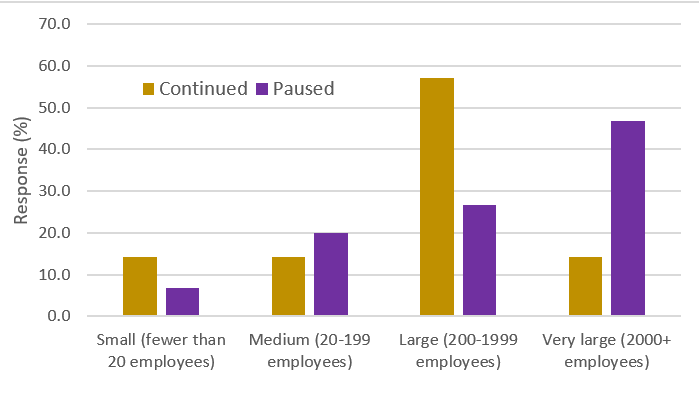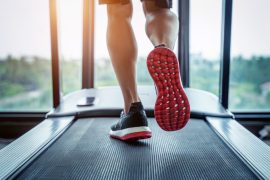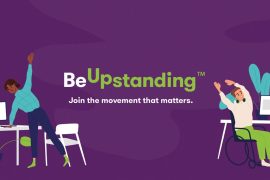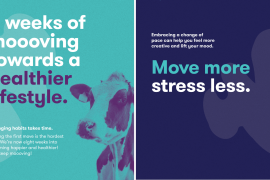COVID-19 has changed the way we live, connect and work. During these unprecedented times, significant changes within the workplace have been taken to reduce the spread of COVID-19 and ensure the health and safety of our communities. Here at team BeUpstanding we recognise that changes in the workplace and business operations presents new opportunities and challenges for BeUpstanding Champions and their teams. To understand this further, and to inform how the BeUpstanding program could be adapted to meet current and future needs that reflect the changing working environment, we conducted a quick snapshot survey with champions and teams taking part in the BeUpstanding implementation trial. The survey was sent in May 2020 when the COVID-19 situation was still rapidly changing in the Australian context. UQ Master of Public Health student, Sidara Engelhardt, has been conducting a deep dive into the findings from the snapshot survey sent to the champions – check out his summary of the findings below.
Our participants
The survey was sent to 65 champions with 27 completing the survey. Participating champions were predominantly from Queensland (48%) and New South Wales (33%) with representation also from Victoria (4%), Western Australia (8%) and South Australia (7%). Responding champions had varying roles within their organisation, with 20% being senior management or executive leaders, 40% were team leaders, and 40% were employees. A huge thank you to all the champions who took part!
We asked champions three questions:
- How has COVID-19 impacted your team?
- How has COVID-19 impacted on your ability as a champion to deliver the BeUpstanding program?
- What is the current priority in your organisation for a program such as BeUpstanding?
Impact on the team
We asked our champions to report on key areas relating to how COVID-19 has impacted their work team, with champions allowed to enter multiple responses. Across the board a majority of teams had transitioned to a work from home environment (83%), while about half of the respondents reported increased workload or a change in tasks for their team. Almost half (45%) reported change in type of work tasks, while only a small proportion (14%) indicated loss of employment or hours. Notably, of the teams who reported loss of employment or hours, all except one had paused the BeUpstanding program.

Impact on the delivery of the BeUpstanding Program
We asked our champions how COVID-19 has impacted their ability to deliver the BeUpstanding program. We identified several key themes amongst the responses and grouped them by whether they had paused, continued, or finished the BeUpstanding program. We found that over a quarter of teams (26%) had continued running the program and almost a fifth of teams (19%) had successfully finished the program. More than half (56%) of the champions reported their team had temporarily paused the program. Notably, no champions planned to stop the program. Interestingly, we observed that Champions working in very large organisations (2000+ employees) had a much higher incidence of pausing the program compared to small (fewer than 20 employees), and large (200-1999 employees). Additionally, champions in team leader or senior management/executive positions were slightly more likely to pause the program.

Many teams expressed that the shift from working in the office to working from home was a key reason for pausing the program. For the teams that continued running BeUpstanding, several noted no impact of COVID-19 on their implementation of the program, while others noted the need to adapt to delivering the program virtually. Some noted the challenges of keeping staff motivated when working remotely.
[We were] unable to do stretches together due to social distancing rules and changed work hours, staff stopped going on 20-minute walks due to the restrictions in place. Now using e-mails to get staff motivated by sending a ‘quote of the day’, to remind them that they need to stretch.
Priority of the BeUpstanding Program during COVID-19
We asked champions what their current priority was within the organisation for a program such as BeUpstanding. A majority of champions (56%) reported that it was now a lower priority because of COVID-19, 33% said it had not changed and 11% reported it was a higher priority for their organisation. Several champions also commented their team/organisation had recognised the program has increased importance due to COVID-19 given the new work environment is more conducive to sedentary behaviour.
“Most of our organisation went to working from home, we are now in a graduated return process over the coming months. With many working from home, they are at risk of becoming more sedentary, so we see this program as key to promote movement at home and implement change.”
Of the teams that had paused the program, the majority expressed enthusiasm to resume the program when possible. Furthermore, champions identified that changes to the traditional workplace environment (e.g. working from home instead of the office) may potentially remain in place for the long term.
As COVID-19 restrictions ease & workloads begin to return to normal we envisage there may be changes to our working conditions with some staff working from home some days on a regular basis.
How is BeUpstanding supporting teams in this new normal?
In response to the changing work environments, we updated the toolkit and developed a series of new BeUpstanding resources to support the work-from-home environment. These resources are freely available on the BeUpstanding website.
The COVID-19 snapshot survey was conducted in May 2020. Since then we have had over 600 champions register to BeUpstanding, highlighting the importance and need for wellbeing programs during these unprecedented times. In this “new normal”, our champions have shown they can support their workers to sit less and move more – no matter where they are working.
This blog post was written by Sidara Engelhardt as part of his Master of Public Health placement with the BeUpstanding team.
![]()










Comments are closed.